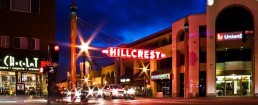A response to Hillcrest Business Association’s Campaign against Uptown Bikeway

Our friends at Hillcrest Business Association (HBA) have resumed their social media push to gut San Diego Association of Governments (SANDAG) Uptown bikeway. While tempting to ignore the HBA’s stale talking points, we recognize their prior effectiveness in preventing bike lanes. They successfully lobbied SANDAG to eliminate the planned protected bike lanes on University Ave in western Hillcrest.
Therefore, here is a brief bullet response to HBA's recent social media effort.
1) This is not a “bikeway to nowhere.” The planned protected lanes on 4th & 5th will take bicyclist from Downtown to Hillcrest. This will connect to planned improvements past the hospitals to Bachmann and into Mission Valley. If anything, HBA lobbying reduced the utility of the network by creating a hole in the network on University in 2015.
2) The HBA appears to be claiming the segment from 4th/5th to 3rd on Washington St is unsafe. If HBA is claiming these blocks of Washington St are unsafe, SANDAG and the city should take action to remedy this problem. However, back in 2014, the HBA believed Washington was a preferred alternative to planned route on University. After they successfully created a hole in network on University, they believe Washington St is dangerous.
3) While the HBA focuses on parking losses of about 16 spaces in the Hillcrest core, they neglect to mention the hundreds of empty spaces SANDAG identified in a single Hillcrest garage. The also neglect to mention the 4th & 5th cycletracks will create 55 additional spaces throughout the length of the route.
4) The HBA has taken a recent Voice of San Diego story out context. One traffic engineer did express concern that mode share goals were “not based on anything.” However, if you read the city’s Climate Action Plan, the basis for the mode share is clearly articulated in the appendix. The entire plan identifies the reduction in greenhouse gases for each strategy identified to reach the city’s goal of eliminating half of all greenhouse gases. Thankfully, this policy was written by environmental policy wonks, not traffic engineers. The VOSD story simply highlights the internal struggle of city staff to buy into the new city policy.
5) The HBA has stated that bike lanes harm businesses. This is simply not based on facts. Even our local San Diego Union Tribune concluded, “Bike lanes, even when they displace parking spots, make little impact on the numbers of customers for local businesses”.
6) In July 2016, the Hillcrest Business Association attempted to stall the Uptown Bikeway by preventing the environmental approval at a SANDAG board meeting. Former City Councilmember Todd Gloria remarked any further gaps in the planned bikeway would just cause opponents to attack the remaining segments in Mission Hills, Old town and Eastern Hillcrest. Gloria’s assertion that bikeway opponents (led by HBA) will never be satisfied has been confirmed by the HBA renewed social media push.
As Hillcrest Business Association mobilizes its significant resources to pressure Councilmember Chris Ward ( christopherward@sandiego.gov ) and Mayor Kevin Faulconer ( kevinfaulconer@sandiego.gov ), please thank these elected officials for supporting safe streets in Hillcrest. (Include BikeSD on your communications, talk@bikesd.org). Or if you prefer twitter for communication, @ChrisWardD3 and @Kevin_Faulconer (still, include us @bikesd).
UC San Diego's Bike Un-Share
After racking up more than 1000 free rides per day, the new (but unauthorized) Ofo bike share system was removed by UC San Diego officials last month. Despite the obvious demand for bike share, and a four-year-old UCSD undergraduate report describing a bike sharing system for campus, officials pulled the plug on the program.
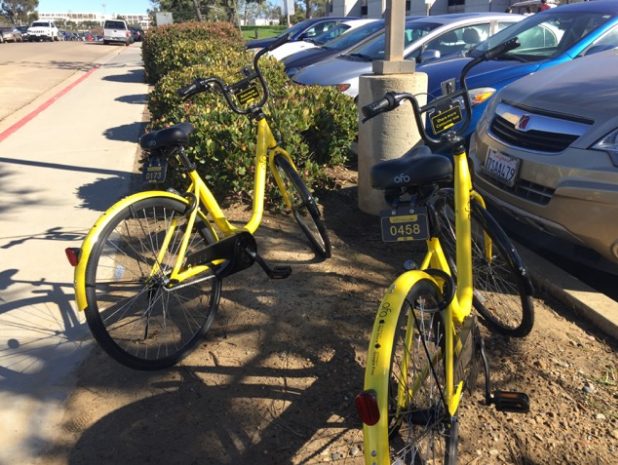
Ofo’s “insurance policies did not meet campus requirements when reviewed by UCSD Risk Services”, according to UCSD Marketing and Communications Director Laura Margoni. In addition, a UCSD police officer explained that no procedure for maintaining or repairing Ofo bikes existed.
Dumping 300 bikes on campus meant Ofo was using the same business model disruption method as Uber, Lyft and Airbnb. Had these sharing economy companies waited for permission from officials - who were often unwilling or unable to comprehend the need for such services - they wouldn’t have succeeded. Similarly, Ofo demonstrated the large demand for bike share at UCSD by bypassing campus rules set by administrators who disregarded years of requests for such a program. After the bikes were removed, UCSD Transportation Services Marketing Manager Curt Lutz said:
“It is my understanding that the impression left by the OFO experience was that there is likely demand for a well implemented bike share program that has a sustainable funding model or to be piloted for trial of competitive models.”
Wasn’t this demand communicated to UCSD by the undergraduate report four years earlier, by multiple students and employees, and in employee parking and sustainability surveys? And while most municipalities have worked out agreements with unauthorized sharing services, UCSD instead removed a bike share system that cost nothing to install, with no official communication about its replacement. (Meanwhile every temporary parking lot closure is announced to campus.) Mr. Lutz again:
“We have been working on a review (internally and with cooperation of SANDAG staff) of bike share vendors, technologies and programs for the past several months to evaluate moving forward with an RFP or RFI (Request for Proposal/Information). UC Riverside and UCLA are just launching programs with two of the prospective vendors offering different technologies. At this time we believe that there is value in monitoring these implementations as part of our process. We are currently working with campus Procurement to scope options for bike share services including business models like OFO.”
Nearly 100 U.S. campuses had bike share systems in 2010, including UC Irvine. UC Berkeley will implement Bay Area Bike Share shortly - without monitoring UCLA and UCR. Yet UCSD still needs to monitor these programs before issuing a Request for Information? Encouragingly, Margoni states that a bike share pilot will roll out at UCSD this fall.
A bike share program is important to UC San Diego for a number of reasons. The freeway-like roads (or stroads) surrounding campus make conditions too dangerous for many off-campus residents to commute by bike:
- Genesee Avenue on the north side of campus is 6+ lanes of 60 MPH+ traffic just inches from riders (here’s audio of a KPBS reporter attempting to bike it).
- The $105 million dollar Genesee Ave bridge being built over I-5 will be 10 car lanes wide, yet there wasn’t enough room for a protected bike lane.
- La Jolla Village Drive is also 6+ lanes of 50 MPH+ traffic, with pedestrians being hit and killed on its curving, high-speed I-5 on-ramps.
- Gilman Drive is 4+ lanes of 60 MPH+ traffic, with aggressive drivers often veering into the bike lane to cut into the I-5 south onramp queue.
As a result of the above, many commuters use SDMTS bus routes that take them to the Gilman Transit Center, on the south side of campus. This a 15-30 minute walk to many buildings on the vast UCSD campus, and bike share would address this first/last-mile problem of public transit. UCSD does offer a useful shuttle system, but if you miss one it’s still faster to walk.
Some students do use the limited bike racks (two) on MTS buses, but they are vulnerable to the massive bike theft problem on campus. Bike lockers would offer increased security but these do not exist at UCSD, despite my requests for installation several years ago.
While biking could shorten the long walk times between buildings, it is actually against the rules to ride a bike on either of the main north-south campus routes, from 8:30 AM to 5 PM. As a result, students frequently receive costly tickets simply for biking to class. As this report from CirculateSD suggests, why not simply create dedicated bike lanes on these routes and elsewhere on campus? BikeSD covered San Diego State’s new bike lanes back in 2011:
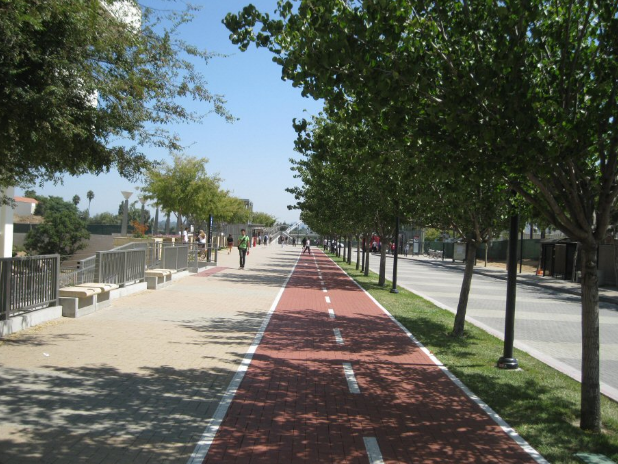
Instead, the Grove Path bike lane was installed for a short segment between the two main north-south UCSD pedestrian-only routes. Pedestrians often use the bike-only Grove Path lane, and are not cited for doing so.
Since bike share helps solve the last-mile problem of public transit, UCSD’s removal of Ofo contradicts the university’s attempts to increase the number of commuters using alternative transportation to campus. Proclaiming “Sustainability is in our DNA”, UCSD’s 2008 Climate Action Plan seeks to decrease the number of solo-driver commuters from 49% to 39% by 2018, via increased biking, walking, and public transit usage. Transportation is the largest contributor to greenhouse gas emissions in California, and San Diego faces severe coastal impacts from a predicted 10-foot sea level rise by the end of the century:
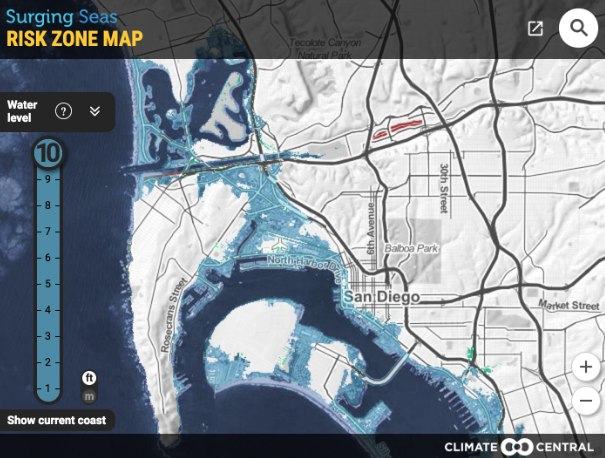
However, since its Climate Action Plan was announced, UC San Diego has taken the following actions with respect to transit:
- Terminated its free bus zone program for students and employees (employees can receive an EcoPass discount)
- Removed a free bike share program
- Endangered bicyclists on Expedition Way and Voight Drive, by adding street parking to these narrow, hilly roads
- Supported the $6.5 billion dollar widening of I-5 in North County - which includes no bus routes servicing campus
- Announced the construction of three new parking garages on campus, despite the Mid-Coast Trolley’s arrival in 2021
UCSD’s goal of reducing single occupancy commuters is shared by the UC Office of the President (UCOP), which publishes an annual report outlining mode share rates and reduction goals:
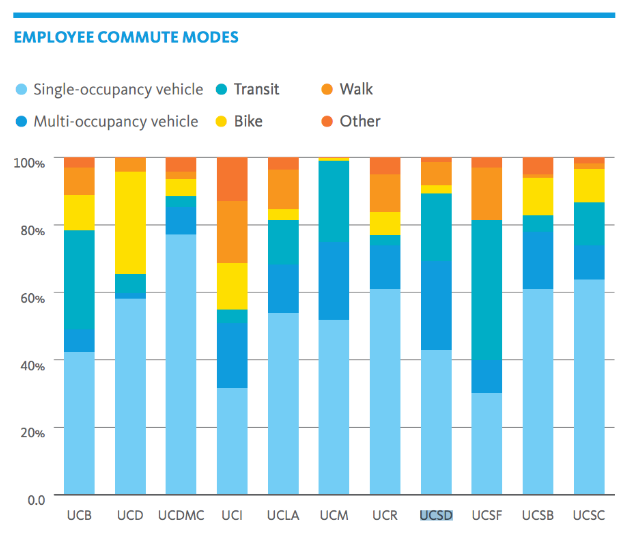
However, UCSD’s mode share numbers above are for all commuters entering campus, including students - not employees, as the report indicates. Since the university has no way to distinguish students from employees in its semi-annual counts, the employee single occupancy vehicle number shown above is incorrect (a commuter mode share survey was recently launched to address this misrepresentation), and skewed downward by the large number of students using public transit. Students voted overwhelmingly to pay a quarterly fee for discounted bus service after the free bus zone was killed, and the MTS 201/202 Super Loop has the highest ridership per revenue hour in San Diego’s bus system.
It should be noted that UCSD has taken some positive steps regarding alternative transportation, including the well-intentioned Grove Path above, and planning for Class II (unprotected) bike lanes on a short segment of Gilman Drive and the new Voight and Gilman bridges. UCSD is contributing at least $1.2 million to the Gilman Drive bridge, which will provider a calmer east-side route to campus. UCSD also provided 1.6% of the funding for the Genesee/I-5 project, which will include a bike path connecting campus to the Sorrento Valley Amtrak station. Yet many of the projects identified in the 2012 Bicycle and Pedestrian Master Planning Study still have not begun, nor has funding been identified.
Further, UCSD’s alternative transportation spending is constrained by its limited sources, which are parking and ticket revenue. (UCOP goals for increasing alternative transit usage aren’t backed by significant funding.) And employee parking permit fees don’t come close to paying for the $100 million-plus cost of multiple new parking garages planned for campus (Torrey Pines North Living/Learning Neighborhood, Mesa Nuevos and Osler). Given the rapid rise of ride-sharing services like Uber/Lyft, does it make sense for the university to continue building costly parking garages? As ride share systems test flat-fee pool programs, new and inexpensive options will exist for automobile commuters to skip vehicle storage on campus.
If sustainability is truly in UC San Diego’s DNA, it should be leading state efforts to reduce greenhouse gas emissions from transportation. Removing a free bike share system that complements public transit isn’t leadership, nor is it consistent with UCSD’s sustainability claims.
Will Councilmember Ward Prevent Additional Delays and New Holes to the Uptown Bikeway Project?
UPDATE: After subsequent conversations with SANDAG, Councilmember Chris Ward has committed his support to the original construction phasing. This will allow the entire protected bikeways on 4th and 5th Ave to be completed as planned. Construction of this segment is planned to start in 2018. BikeSD would like to thank Councilmember Ward for the continued support of Uptown Bikeways.
Recently we learned that Councilmember Chris Ward had made a request to delay the protected bicycle lane on Fifth Ave between University and Washington from the 1st construction phase to the 3rd construction phase in the Uptown Bikeway project. This would delay the implementation by 3 years. BikeSD Executive Director Sam Ollinger and Board President Jeff Kucharski met with Councilmember Ward and his staff earlier this week to discuss this issue. BikeSD asked for Councilmember Ward to reconsider his request. Below is the follow-up email to his office summarizing our meeting and discussion.
Dear Councilmember Ward and Ms. Bailey,
Thank you for taking the time to meet with representatives of BikeSD. As we discussed we wanted to follow up with you over email on a few items:
-
Since the Uptown Bikeway is part of the Early Action Projects that the SANDAG committed to completing within 10 years when they voted to adopt the 2050 Regional Transportation Plan back in 2011, it is important that no additional delays or gaps be created in the network. The project has had both unprecedented community outreach and feedback (>100 stakeholder meetings). It received environmental clearance in July 2016. Any further delays or gaps in the network will only delay the project's construction and establish a terrible precedent for future bikeway projects in the region.
-

Fourth and Fifth Avenue Proposed Alignments. Image source: SANDAG Here is a map showing the construction phasing of the Uptown Bikeway project. As we mentioned in person, delaying the Fifth Avenue segment between Washington Avenue and University Avenue is both unacceptable and unnecessary since it will create a break in the protected bikeway network. The Fourth and Fifth Avenue segments are protected bikeways as you will see here. The planned 3rd phase along Bachmann Place is different style facility than the Fourth & Fifth protected bike lanes. As the planned bikeway will rely on sharrows northbound from Washington to Lewis, no purpose will be served by delaying a single section of Fifth ave protected bike lane. Based on SANDAG program budget, the Third phase construction would not begin until 2021, 3 years after the Fourth & Fifth segments' construction began.
- Councilmember Ward, as an urban planner, you know the critical importance of mobility and urban development as key tools to attaining the goals the City Council committed to when it adopted the Climate Action Plan. SANDAG's own projections show increased population growth in District 3 and the time to ensure the implementation of a contiguous and safe bikeway network in District 3 is now.
- Finally we do want to express our thanks about the good news in the new bike lanes that will be striped along India, Redwood, and Jackson Drive. If you have additional information about the dates when they will be ready - we would love to write about it on the BikeSD blog.
Thank you. Please feel free to contact us.
Sincerely,
Jeff Kucharski, Board Chair, BikeSD
Sam Ollinger, Executive Director, BikeSD
Please help us fight the good fight and sign up to volunteer for the upcoming Bikes and Beer ride on April 8th! We need ride leaders and help at registration. Thank you!
Join Your Community Planning Group to Make San Diego a Better Place to Ride
Once a month volunteer residents in over 50 community planning areas meet to advise the City of San Diego on land use decisions. Community planning groups (CPGs) provide guidance on a wide range of issues, from the large, multi-year community plan updates to individual residential and commercial developments. To learn more about what community groups do and how to get involved, consider attending attending our next member meetup on March 6 at Iron Pig Alehouse in Pacific Beach. Circulate San Diego will be joining BikeSD to discuss how residents can (and should) get involved in local planning groups to help create a world-class city for biking.

Any effort to improve bicycling in San Diego is basically a land use decision; therefore, these groups play an important role in making San Diego a world class bicycling city. As an organization, BikeSD, encourages bicycle riders everywhere to join their community groups. While a CPG role is strictly advisory, these groups remain influential. We have highlighted a few recent examples to show how these groups have helped or inhibited our effort to improve bicycle infrastructure in San Diego.
- In March 2015, Uptown Planners held a special meeting to address the Uptown bikeway. Despite the passionate pleas of bicyclists, the Uptown Planners supported 4 motions that weakened or opposed the planned bikeway. Less than ten weeks later, the SANDAG transportation committee officially created a hole in the planned network by abandoning any improvements in western Hillcrest.
- In the “Complete the Boulevard” study, the need for dedicated bicycle infrastructure were widely ignored. While city staff did study these options, they were excluded after Kensington-Talmadge and City Heights CPGs made it clear that they would only support sharrows (or no bike infrastructure) on El Cajon Boulevard.
- The ridiculous creation of a hole in the Uptown Bikeway caused advocates to mobilize and join the Uptown CPG (including BikeSD endorsed candidates). The personnel change provided immediate sanity as the board passed a series of motions supporting a continuous east-west corridor. In a passionate defense of 4th and 5th Ave. segments of the planned Uptown Bikeway, former District 3 Councilmember, Todd Gloria, cited these changes in the local CPGs as positive sign of support for the project.
- City staff has cited the Uptown CPG’s motion to close the “Gap” when presenting the proposed “Hillcrest Gap” solution.
- The planned transformation of downtown San Diego’s streets, Downtown Mobility plan, was supported by the Downtown CPG. The San Diego City Council unanimously supported the plan in June of 2016.
Every community in San Diego should be a great place to safely ride a bike. Community planning groups play a large role in whether that happens. Whether it is advocating for secure bike parking at a new development or supporting a road diet, we need support (even minority support) on CPGs. If your community has either an upcoming community plan update (Clairemont, Old Town/Midway, Kearny Mesa) or is home to one of SANDAG’s early action bicycle projects, your CPGs will play a very important role in our transportation future.
Each planning group has slightly unique eligibility rules for elections. All CPGs hold elections in March. If you choose not to join a CPG, please consider voting (and bring friends) for bicycle friendly candidates!!
SANDAG's Executive Director Gary Gallegos Must Step Down
This past Monday, Voice of San Diego’s Andrew Keatts, revealed the story of the stunning public deception carried out by our regional planning agency, SANDAG, led by the agency’s executive director Gary Gallegos.
To recap, SANDAG put a sales tax measure on the ballot last November and it failed to garner the required 2/3 votes in part because organizations like BikeSD opposed the measure. SANDAG’s proposal was to raise $18 billion to spend on transportation projects, but a large portion of those funds would have gone toward expanding and building more highways—an attempt at marginal gains to address congestion problems in the region.
In Keatts’ piece, we learned that the revenue projections for the tax measure were inflated and yet, “the agency’s board of directors approved putting the $18 billion spending plan before voters.”
We already know that Gallegos is a man without any vision, given his statement, “Transit is not going to work for every person in the region.”
On Tuesday, Keatts, followed up on the SANDAG bombshell story with some statements from the agency’s board chair, Supervisor Ron Roberts who stated he had no idea what was going on with the organization because he wasn’t told anything.

For an agency managing one of the largest sources of public dollars, not knowing is simply not acceptable as a response. Supervisor Roberts can’t simply disregard this gross act of public deception and except the public to have faith in either his ability to govern or in the agency’s ability to solve the region’s problems related to transportation or even housing. Furthermore, having a leader running a government agency that lacks vision beyond the highway-centric one from sixty years ago isn’t the way forward.
The SANDAG Board of Directors is currently at a retreat this week and we have to make it clear that when they return from that retreat, we expect new staff leadership—no excuses.
So we are calling on SANDAG’s Gary Gallegos to step down as executive director.
Make the call to change the corrupt nature of one of our most important regional agencies:
Board Chairman Ron Roberts: (619) 531-5544
San Diego Mayor Kevin Faulconer: (619) 236-6330
For more information please read this commentary by former BikeSD President, Andy Kopp.

